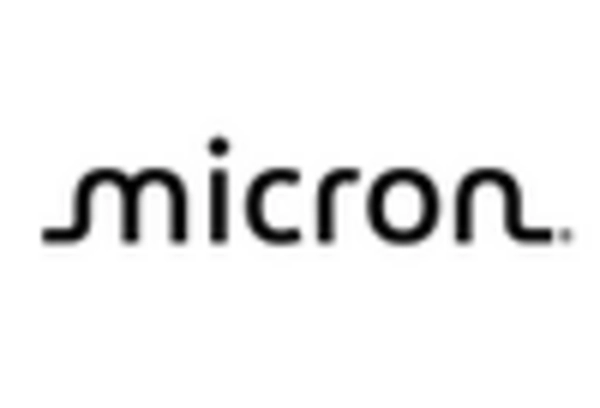Rising Semiconductor Applications
The market is experiencing a notable surge due to the increasing applications of semiconductors across various industries. As technology advances, the demand for semiconductors in consumer electronics, telecommunications, and computing is expanding. In 2025, the semiconductor industry in the US is projected to reach approximately $200 billion, with silicon wafers being a critical component. This growth is driven by the proliferation of smart devices and the Internet of Things (IoT), which require high-performance chips. Consequently, the silicon wafers market is likely to benefit from this trend, as manufacturers strive to meet the escalating demand for efficient and powerful semiconductor solutions.
Advancements in Electronic Devices
The silicon wafers market is significantly influenced by advancements in electronic devices, particularly in the consumer electronics sector. As devices become more sophisticated, the need for high-quality silicon wafers increases. The market for smartphones, tablets, and wearables is projected to grow substantially, with an estimated value of $500 billion by 2025. This growth is likely to drive demand for silicon wafers, as manufacturers seek to produce smaller, more efficient chips that enhance device performance. The continuous innovation in electronics suggests a robust future for the silicon wafers market, as it adapts to the evolving needs of consumers.
Expansion of Renewable Energy Technologies
The silicon wafers market is poised for growth as the renewable energy sector expands, particularly in solar energy applications. Silicon wafers are essential in the production of photovoltaic cells, which convert sunlight into electricity. The US solar market is expected to grow at a CAGR of around 20% through 2025, driven by government incentives and a shift towards sustainable energy sources. This transition not only supports environmental goals but also stimulates the silicon wafers market, as manufacturers increase production to meet the rising demand for solar panels. The integration of silicon wafers in renewable technologies indicates a promising future for the industry.
Growing Demand for High-Performance Computing
The silicon wafers market is experiencing growth due to the rising demand for high-performance computing (HPC) solutions. Industries such as artificial intelligence, big data analytics, and cloud computing are driving the need for powerful processors, which rely heavily on advanced silicon wafers. The HPC market in the US is projected to reach $50 billion by 2025, indicating a robust demand for silicon wafers that can support these high-performance applications. As organizations seek to enhance their computational capabilities, the silicon wafers market is likely to expand, providing essential materials for the next generation of computing technologies.
Increased Investment in Research and Development
The silicon wafers market is benefiting from increased investment in research and development (R&D) within the semiconductor industry. Companies are allocating substantial resources to innovate and improve wafer production processes, which enhances efficiency and reduces costs. In 2025, R&D spending in the semiconductor sector is expected to exceed $30 billion in the US. This focus on innovation is likely to lead to the development of advanced silicon wafers with superior properties, catering to the growing demands of various applications. As R&D efforts intensify, the silicon wafers market is positioned to thrive, driven by technological advancements and improved manufacturing techniques.














Leave a Comment